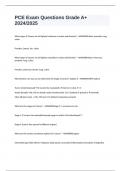PCE Exam Questions Grade A+
2024/2025
What types of Cancer are of highest incidence in males and females? - ANSWERSMales: prostate, lung,
colon
Females, breast, lun, colon
What types of Cancer are of highest mortality in males and females? - ANSWERSMales: Pancreas,
prostate, lung, colon
Females: pancreas, breast, lung, colon
What System can you use to determine the Stage of Cancer? Explain it - ANSWERSTNM System
Tumor (extent/spread)→Tx (cannot be evaluated), T0 (tumor in situ), T1-4
Nodes (lymph)→Nx, N0 (no lymph nodes involvement), N1-3 (extend of spread or # involved)
Mets (distant ones) → Mx, M0 (no), M1 (distant metastasis present)
What are the stages of Cancer? - ANSWERSStage 0 = carcinoma in situ
Stage 1-3 (cancer has extended beyond organ in which it first developed)*?
Stage 4 (cancer has spread to different organs)
What are the various treatment options for Cancer? - ANSWERSSurgery
Chemotherapy (Side effects→alopecia (bald spots), mucositis (inflammation/ulceration of digestive
,tract), pulmonary fibrosis, cardiotoxicity (damage to heart), renal failure, sterility, myalgia,
neuropathy)
Radiation (Side effects→skin irritation, scar tissue, hair loss (permanent or transient), temp change in
skin colour, FATIGUE, swallowing discomfort)
Hormone Replacement Therapy
Biological/Genetic Treatment
How can someone who has Cancer present clinically? - ANSWERSROM limitations (need shoulder range
for radiation in breast cancer)
fatigue
myalgia (muscle pain)
arthralgia (joint pain)
chemotherapy induced peripheral neuropathy
deconditioning
look for any recurring signs of cancer
What can PT's help with when someone has Cancer? - ANSWERSfatigue management
function and mobility management
,physical symptom management
psychological symptom management
ACUTE: mobility, general strength/mobility, bed positioning
What precautions should we be aware of when exercising someone who has cancer? - ANSWERSswollen
ankle, fatigue, vomiting and diarrhea, unexplained weight loss/gain, SOB with low level of exertion
What contraindications should we be aware of when exercising someone who has cancer? -
ANSWERSracing pulse, fever, pain in back or neck or bone, calf pain, chest pain
nauseated while exercising, confused or disorientated, dizzy or faint
blurred vision, sudden SOB, very weak or tired
What are potential S/S of a Brain Tumour? - ANSWERSdull, constant ache
agg by being upright, cough, sneeze
not rhythmic or throbbing
relieved by aspirin
no nausea
does not disturb sleep
sometimes severe
, What is Anemia? How can it affect exercise? What are normal values? - ANSWERSAnemia is low amounts
of Hb levels that effects the amount of O2 that can be carried to the cells
Exercise needs to be scaled back if below 8g/dL
males (14-18 g/dl) / females (12-16 g/dl)
What is Neutropenia? How can it affect exercise? - ANSWERSLow WBC counts which relates to person's
ability to fight infections
Should be > 1000mcL
Risk of infection increases if absolute neutrophils falls <500mcL (avoid public fitness or areas, facilities
and activities with inc exposure to viral and/or bac infection, avoid exercise if have fever (temp greater
than 37.5 degree F))
What is Thrombocytopenia? How can it affect exercise? - ANSWERSLow platelet count (normal = 150-
400,000/mcL) which increases risk of bruising/bleeding
If <50,000 = amount activities w contact/risk of falling (low weight, low resistance/no resistance on
stationary bike, walking/ADLs)
If <20,000 = incr risk of spontaneous bleed unrelated to trauma (need Dr approval, AROM, walking, ADLs
w potential supervision)
If <10,000 = spontaneous CNS/GI/respiratory tract bleeding (no exercise, only essential ADL)
What is Lymphedema? - ANSWERSSwlling due to lymph node dysfunction
Normally occurs in limbs (hands/feet) but can also affect organs)




